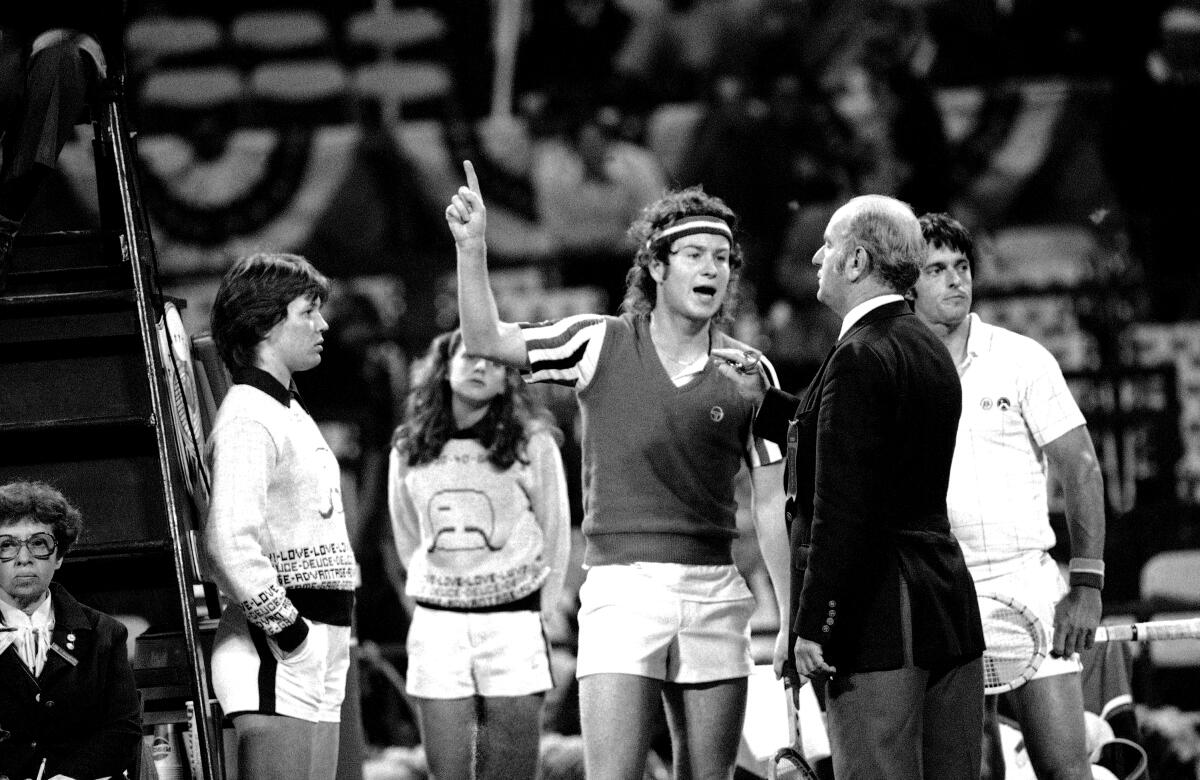Commentary: ‘You cannot be serious’ about taking John McEnroe-esque fire out of tennis

- Share via
INDIAN WELLS — You’ve seen the TV ad.
An elderly looking John McEnroe spills red sauce from his cafeteria tray onto his white tennis shorts, as Serena Williams destroys attacking ball machines with lethal forehands and backhands.
“You cannot be serious,” McEnroe whines, repeating an act that once got him in hot water with a tennis chair umpire and that he has parlayed into a zillion-dollar brand.
Well, no more, John. The chance for tennis players to argue calls is over. Now, they have to take on machines, which means there is now no element for controversy. There will be no controversy, tennis has decreed.
The electronic line calling system called Hawk-Eye is now Hawk-Eye Live. It not only calls all the lines, but has a loud female voice confirming what the camera has seen, and ruled. The ball misses a line and a voice out of the sky somewhere — we will call her the Tennis Wizard of Odd — barks that the ball is OUT. That gets a little weird when the player hits a serve into the net. “Out,” barks the Wizard of Odd, even though the shot wasn’t really out, just short.

In the recent past, the scoreboard listed a number of challenges for each player. That meant that, were they to question a call by a linesperson, the chair umpire would call for an electronic review, Hawk-Eye would replay the shot on a big screen and the crowd would cheer or moan, depending on their allegiance, as they saw the electronic evidence of the shot’s landing spot.
No longer. Players don’t get challenges. There are no lines people anymore, only a chair umpire who, most probably, will never reverse a call. No future in taking on a machine. That makes the chair ump job mostly button-pushing. Players get to ask for a “close-call” review. But golly, do you think the machine that made the call is going to show that it made a mistake? To the surprise of no one, zero corrections have occurred. Players watch the close-call review quietly, shrug and carry on. Pretty exciting stuff.
There are still ball kids, but how long do you think that will last? Some geek is surely sitting somewhere in a dingy basement, inventing an app that will allow the chair umpire to activate an on-court vacuum that will scoop up all the balls and bounce them gently to the serving player. It will be a huge savings for tournaments, which is the genesis for all these things. This way, they won’t have to buy the ball kids hamburgers anymore.
Where tennis is headed is zero controversy. The competitive spigot for so many of these adrenaline-filled, hard-charging, world-class athletes has been turned off before they even step on the court. Why argue with a machine?
McEnroe was embarrassing some of the time, but really fun some of the time, too. Spectators can now expect robotic, emotionless matches. Tennis has always had this white-clothing, vanilla image. Hush hush. Be nice. McEnroe stomped on that for a while and its only result was, say, 5 million more people paying attention to the sport. Now, the most controversial thing left might be some of the female players’ loud grunting. They will soon find a machine to filter that out, too.
The BNP Paribas Open returns to Indian Wells after the coronavirus sidelined the event for two years. U.S. Open champions are among those competing.
Speaking of noise and controversy, there actually was some here Thursday night, and it brought back memories of the great and semi-wacko Goran Ivanisevic, the delightful Croatian, who always told it like he thought it was — especially to umpires, linesmen and sportswriters — and somehow survived all that to win a Wimbledon title in 2001 after being runner-up three times.
More than his huge serve and fine forehands, backhands and volleys, Ivanisevic possessed the finest racket throw in the history of the game. He did it with pride, with classic follow-through, with not only intent but certainty that the frame would smash and he would lose a point and several thousand dollars.
Once, here at Indian Wells, he saw another player try to smash his racket and fail. Only a nice dent had been achieved. The next day, clearly concerned about this breach of a tennis skill, Ivanisevic conducted a verbal clinic in his post-match news conference on the skills and technique involved in making sure that the racket would break. It was clinical.
So, had Ivanisevic been here watching when veteran Vasek Pospisil of Canada lost his serve to go behind in the third set, 3-1, and promptly demolished his racket, he would have been proud. It took four giant whacks into the hard-court surface before the handle parted ways with the rest of the racket, but Pospisil got it done.
Pospisil actually gathered himself, after a discussion with the chair umpire that involved the word “fines,” and went on to win the match. And he ended up not getting fined.
That meant that two good things had happened. A contribution to tennis of the legendary Goran Ivanisevic was honored. And a chair umpire actually had something to do besides push buttons.
Consider that a glimmer of hope for this sport.
More to Read
Go beyond the scoreboard
Get the latest on L.A.'s teams in the daily Sports Report newsletter.
You may occasionally receive promotional content from the Los Angeles Times.










